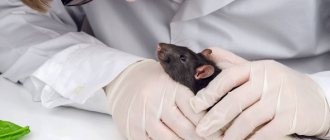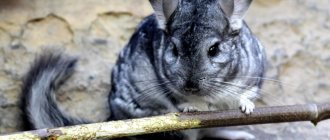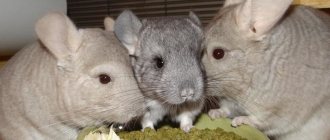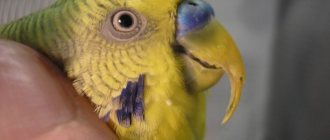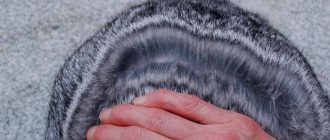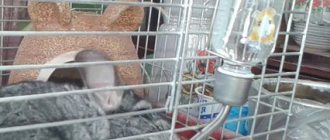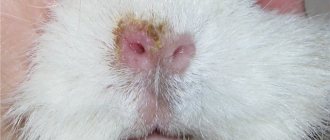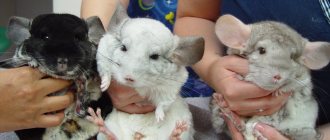Signs of ill health
You can suspect the presence of the disease based on the following signs:
- Change of behavior. The chinchilla becomes lethargic.
- Loss of appetite.
- Nasal or conjunctival discharge.
- Diarrhea.
- Dermatitis.
- Hair loss.
- Change in tooth color.
- Unpleasant odor from the mouth.
- Pathologies of the genital area.
Having noticed such symptoms, the owner is obliged to find out whether the conditions of detention, as well as the pet’s nutrition, comply with the recommended standards, and correct the detected deficiencies. The biology of a rodent is not comparable to that of a human, so trying to treat a chinchilla disease can do more harm than doing nothing.
It's sad to be sick
Chinchilla has worms and hair is coming out
Chinchilla has worms and hair is coming out
Message number: #1 Alexey » Mon Jan 05, 2009 01:28
If you do not want to see this block, register or log in under your name.
Message number: #2 Anika » Mon Jan 05, 2009 10:26
In order
1. We had the same thing, we took tests and said that it was not lichen, we didn’t treat it with anything, and after some time new lesions appeared. They began to treat with Exoderil (an antifungal agent (solution) sold in human pharmacies). In principle, chinchillas do not have many skin diseases accompanied by hair loss. This could be alopecia (hair loss), they don’t really know what causes it, but they assume that due to poor nutrition, lack of vitamins, the fur will grow back after some time with proper care. Eating their own fur is caused by changes in the adrenal glands and pituitary gland (it is quite rare and looks terrible, in chinchillas something appears in the form of a lion's mane). So this is definitely not your case. Well, Dermatotoxicosis (fungal diseases), but this disease manifests itself by the appearance of a crust on the skin or peeling. Well, if we take into account all of the above, then there are 2 options: either hair loss, or lichen, or simply pulled out or thrown off as a result of stress (but the clump is quite large. In general, I doubt it). So you need to give vitamins. for example, biovital gel (squeeze a “bead” onto your finger and let it be licked off) or immunoboosting drugs (imunofan or gamavit), and for preventive purposes, anoint with exoderil.
2. Give calcium gluconate half a tablet once a day, most often the chinchilla itself knows how much it needs to eat, chews as much as it needs and throws the tablet. Watch the color of your teeth. Teeth are an indicator of calcium in the body. Should be dark yellow or orange. If your teeth are light, it means there is not enough calcium.
4. It’s damp on the balcony now, so it’s better to store hay and sand in a dry, dark place in the apartment. The best food for chinchillas is Vitacraft Regular, Vitacraft Pellets, Prestige Duo and Prestige Complete. I would exclude Grand Premium from my diet. Prestige nature or xtra-vital can be given as complementary food. I can’t say anything about hay, we haven’t tried it, but what good hay looks like is written in the article with the quote “Hay is an essential part of a chinchilla’s diet. It is better to use meadow hay, with dandelions, clover, alfalfa, and not swamp hay. Swamp hay contains much less useful nutrients than meadow hay. The mowed grass should be young, not yet having time to spike. A point to pay attention to is drying the hay. You need to dry the hay in a dark, well-ventilated place so that it dries thoroughly, does not rot, rot, or lose its beneficial properties. If it is not possible to make hay yourself, then you should be very careful when choosing hay when buying it in a store. The color of good hay is dark green, the yellow blades of grass (straw) in it are no more than 15 percent. The hay should not smell like mold or rot. The hay must be clean, without tree branches or other debris.” Sand. We haven’t tried it either, but you can diagnose it yourself. Peanuts should not be given to chinchillas at all; it is too heavy and fatty food for the chinchilla’s liver. They usually give a quarter of a walnut to pregnant females. It is better to treat the chinchilla with rose hips or give a little dried apple.
5. Chinchillas rarely have worms and worm prevention is usually not done. If you are sure that there are worms, then you can poison them with albendazole or alben s (in fact, this is the same
) the dosage in accordance with the instructions is calculated depending on the weight of the animal.
The fur must run!
My chinchillas: https://chinchillas.by/
. It depends only on the choice of the breeder whether your animal will grow up to be “That’s something!” or “Oh, what is this?!”
Message number: #3 KulMaks » Mon Jan 05, 2009 11:50
I think things could be much simpler. If you bought a chinchilla a month ago, and noticed a lack of fur two weeks ago, then most likely the reason is the move. I doubt it's lichen or other fungal diseases. Most likely a sharp transition to new food, new impressions of moving, new smells, etc. As a result, a malfunction in the body and hair loss. I would recommend monitoring the coat for a week (regularly checking the entire coat for new bald spots by blowing it out). In a week or a week and a half, hair will begin to grow back at the site of the bald spot. If no new outbreaks appear, we can assume that everything is fine
PS It’s right that you didn’t wet the chinchilla
Message number: #4 Lili » Mon Jan 05, 2009 21:34
Message number: #5 Dashka » Mon Jan 05, 2009 21:42
Message number: #6 Anika » Mon Jan 05, 2009 23:01
Heatstroke
Chinchillas lived in the wild in the highlands of South America. They are susceptible to drafts, but most of all to overheating. A temperature of 25 °C is critical for them. This should be taken into account by chinchilla farmers and animal lovers. The main symptoms of overheating are the following:
- Copious salivation.
- Diarrhea.
- Rolling to one side.
- Cramps.
Hyperthermia disrupts the functioning of chinchilla kidneys and myocardium. Without taking action, this condition ends in death. What should an owner do if a chinchilla gets sick before the veterinarian arrives? Transfer the animal to a dark, cool room and cover it with a cloth moistened with cool water. If the attack occurs on the street or in transport, the cage with the rodent must be moved to the shade: the chinchilla does not tolerate direct sunlight.
Classification of especially dangerous infections
All OI are classified into three types:
- Conventional diseases . Such infections are subject to international sanitary regulations. This:
- bacterial pathologies (plague and cholera);
- viral diseases (monkeypox, hemorrhagic viral fevers).
- Infections that require international surveillance but are not subject to joint activities:
- bacterial (typhoid and relapsing fever, botulism, tetanus);
- viral (HIV, polio, influenza, rabies, foot and mouth disease);
- protozoans (malaria).
- Not subject to WHO supervision, are under regional control:
- anthrax;
- tularemia;
- brucellosis.
Respiratory diseases
Chinchillas may develop a runny nose or bronchopneumonia. The animals lack not only sweat glands, but also sebaceous glands. Therefore, chinchilla diseases occur under the influence of a draft, wetness; the animals catch cold easily, and their treatment begins with eliminating the cause.
Rhinitis
In chinchillas kept in an apartment, inflammation of the nasal passages is a consequence of drafts; those living in sheds can get sick due to hypothermia or sudden temperature changes. An allergic reaction to dust, including from excessively crushed feed, cannot be ruled out. The following symptoms occur:
- The nasal mucosa becomes inflamed.
- Breathing is difficult.
- The animal is depressed, rubbing its nose with its paws. He's shaking.
- Runny nose with copious nasal excreta.
- Tearing
- Hyperthermia >38 °C.
If production livestock gets sick, the sick are removed and the rest are treated. Sanitation of the premises with Chloride turpentine in the presence of animals is in demand. Treatment of chinchillas is carried out in courses lasting 5 days. After 2–3 days, the sanitation is repeated. If the need arises, the number of courses is increased to 8. If timely treatment is not carried out, the disease will spread to the underlying sections, bronchopneumonia will form and the animal will die. For preventive purposes, rodents are treated weekly.
At home, antiseptic solutions are dripped into the nose. Penicillin, tetracycline, and sulfonamides are effective. The course of treatment is not <5 days. In severe cases, intramuscular injections must be made.
Bronchopneumonia
If the animal develops wheezing, coughing, matted fur, or the temperature rises to 41°C, this indicates the occurrence of bronchopneumonia, so it is necessary to call a veterinarian who has experience working with ornamental rodents.
Otitis
Occurs in individuals with weakened immune systems or when exposed to drafts or changes in external temperatures. Characterized by rubbing the ears against the cage, scratching them. Pus may leak from the external passage and an unpleasant odor may be felt.
Exudate must be removed using an antiseptic lotion. Do not use warming compresses that create conditions for the proliferation of microflora.
The most common OOIs
The most common dangerous infections:
An acute, particularly dangerous disease that is classified as a zoonotic infection. The source and distributor of the infection are rodents (mainly rats and mice), and the causative agent is the plague bacillus, which is resistant to environmental conditions. Plague is transmitted primarily through transmission through flea bites. From the onset of the disease, it occurs in an acute form and is accompanied by general intoxication of the body.
Distinctive symptoms include:
- intense fever (temperature can rise to 40°C);
- unbearable headache;
- the tongue becomes covered with a white coating;
- facial hyperemia;
- delirium (in advanced cases, when the disease is not treated correctly);
- expression of suffering and horror on the face;
- hemorrhagic rashes.
Plague is treated with antibiotics (streptomycin, terramycin). The pulmonary form always ends in death, as acute respiratory failure occurs - the patient dies within 3-4 hours.
Acute intestinal infection with a severe clinical picture, high mortality rate and increased prevalence. The causative agent is Vibrio cholerae. Infection occurs mainly through contaminated water.
- sudden profuse diarrhea;
- profuse vomiting;
- decreased urination due to dehydration;
- dryness of the tongue and oral mucosa;
- decrease in body temperature.
The success of therapy largely depends on the timeliness of the diagnosis. Treatment involves taking antibiotics (tetracycline) and copious intravenous administration of special solutions to replenish the deficiency of water and salts in the patient’s body.
Black pox
One of the most highly contagious infections on the planet. It is an anthroponotic infection and only affects people. The transmission mechanism is airborne. The source of the smallpox virus is considered to be an infected person. The infection is also transmitted from an infected mother to her fetus.
Since 1977, not a single case of smallpox infection has been reported! However, blackpox viruses are still stored in bacteriological laboratories in the USA and Russia.
- sudden increase in body temperature;
- sharp pain in the lumbar and sacrum areas;
- rash on the inner thighs, lower abdomen.
Treatment of smallpox begins with immediate isolation of the patient, the basis of therapy is gamma globulin.
Yellow fever
Acute hemorrhagic transmissible infection. Source: monkeys, rodents. The carriers are mosquitoes. Distributed in Africa and South America.
Symptoms of the disease:
- redness of the skin of the face and neck in the first stage of the disease;
- swelling of the eyelids and lips;
- thickening of the tongue;
- lacrimation;
- pain in the liver and spleen, an increase in the size of these organs;
- redness gives way to yellowness of the skin and mucous membranes.
If the diagnosis is not made in a timely manner, the patient’s well-being worsens every day, bleeding from the nose, gums and stomach is noted. Possible death from multiple organ failure. The disease is easier to prevent than to treat, so vaccination of the population is carried out in areas where cases of pathology are frequent.
anthrax
The infection is zoonotic and is considered a weapon of mass destruction. The causative agent is a stationary bacillus that lives in the soil, from where animals become infected. Cattle are considered the main carrier of the disease. The routes of human infection are airborne and alimentary. There are 3 types of disease, which will determine the symptoms:
- Cutaneous . The patient develops a spot on the skin, which over time turns into an ulcer. The disease is severe and can be fatal.
- Gastrointestinal . The following signs are noted: sudden increase in body temperature, bloody vomiting, abdominal pain, bloody diarrhea. As a rule, this form is lethal.
- Pulmonary. It proceeds in the most difficult way. There is a high temperature, bloody cough, and disturbances in the functioning of the cardiovascular system. A few days later the patient dies.
Treatment involves taking antibiotics, but more importantly, administering a vaccine that prevents infection.
Bacterial zoonotic infection. Source: rodents, cattle, sheep. The causative agent is a gram-negative rod. The mechanism of penetration into the human body is contact, nutritional, aerosol, transmission.
- heat;
- general malaise;
- pain in the lower back and calf muscles;
- skin hyperemia;
- damage to the lymph nodes;
- macular or petechial rash.
Eye diseases
Eye diseases in chinchillas can manifest themselves as an independent pathology and as a symptom of another illness, mainly respiratory. Additional symptoms besides lacrimation are:
- Cough.
- Nasal discharge.
- Depressed state.
- Labored breathing.
Tearing is detected by wet streaks on the rodent's cheeks. It is necessary to carefully consider the identified symptoms, take measures against the development of rhinitis and call a veterinarian. The most common eye diseases in chinchillas are:
- Conjunctivitis.
- Keratitis.
- Cataract.
Conjunctivitis
Inflammation of the conjunctiva in chinchillas can be primary or secondary. The former is caused by injury or irritation from solid or gaseous substances entering the eye. Secondary conjunctivitis occurs as symptoms of another disease.
Animals receive injuries as a result of fights or damage received during transplantation. It is significant that with conjunctivitis of infectious etiology, both eyes are affected, and with injuries, most often one. Getting dust or food particles into your eyes irritates them and causes watery eyes. If the cage is not cleaned, corrosive gases are released from the decomposing feces, which “cut” the eyes. Smoking in a room with a chinchilla can cause lacrimation in the sensitive animal.
Conjunctivitis is treated with eye drops. How to treat it at home").
Conjunctivitis
Keratitis
Develops from conjunctivitis. If not properly treated, serous discharges transform into mucous discharges, then purulent ones. The cornea is involved in the phlogistic process and keratitis develops. The animal is at risk of losing its sight.
Ulcers form. Treatment can stop the inflammatory process, but the defects become scarred and visual acuity decreases.
Cataract
The disease is characterized by loss of transparency of the lens. The ability to transmit light, and therefore to see, is lost. The cause of the pathology is unknown. There may be an innate predisposition to developing the disease. A cloudy lens in a pet is hard to miss. Highly qualified veterinary specialists have learned to perform lens replacement operations. There is a chance of restoring your pet's vision.
Cataract
List of DPOs
The World Health Organization has compiled a list of more than a hundred diseases that can quickly and massively spread among the population. Initially, according to data from 1969, this list included only 3 diseases:
However, later the list was significantly expanded and all the pathologies that were included in it were conditionally divided into 2 groups:
1. Diseases that are unusual and may affect public health. These include:
- smallpox;
- human influenza;
- polio;
- severe acute respiratory syndrome.
2. Diseases, any manifestation of which is assessed as a threat, since these infections can have a serious impact on public health and can quickly spread internationally. This also includes diseases that represent a regional or national problem. These include:
- cholera;
- pneumonic plague;
- yellow fever;
- hemorrhagic fevers (Lassa, Marburg, Ebola, West Nile fever);
- dengue fever;
- Rift Valley fever;
- meningococcal infection.
In Russia, two more infections have been added to these diseases - anthrax and tularemia.
All these pathologies are characterized by severe course, high risk of mortality and, as a rule, form the basis for biological weapons of mass destruction.
Anomalies of teeth
Healthy chinchillas, like nutrias, have bright orange-colored teeth. Dents subject to decalcification become pale yellow. The main reason is an imbalance in the diet in terms of minerals and vitamins or selective eating of certain ingredients by the chinchilla. The most reliable way to get rid of the disease is to use complete granulated feed. The animal is deprived of the opportunity to choose and consumes all the necessary substances.
Healthy teeth
An imbalance of nutrients provokes the development of a difficult-to-treat dental disease - drooling. It lies in the unevenness of dental growth. The animal has increased salivation, it scatters food and selects softer particles. Gradually, the nose and eyes become inflamed, and discharge forms from them.
Another pathology that causes significant concern to the chinchilla is hooks on the dents. This is a congenital disease characterized by the formation of malocclusion. Treatment boils down to grinding down the teeth with a drill using general anesthesia. You need to understand that sawed incisors grow back. After 6 months the operation must be repeated.
Sick teeth
How to understand that a chinchilla is sick
An attentive owner can guess that the chinchilla is sick by a change in the usual behavior of his beloved animal and external signs of pathology.
- a good appetite;
- high activity and adequate response to the owner’s caresses;
- shiny dry eyes;
- clean nose;
- ears are clean, without scabs and dirt;
- bright orange straight teeth;
- shiny smooth thick fur;
- stable weight of adults 450 – 650 g depending on breed and gender;
- oblong round droppings;
- clean genitals.
By the appearance of the animal it is immediately clear that something is wrong with it.
You can understand that your favorite animal is not feeling well by the characteristic symptoms:
- lethargy, apathy;
- the animal refuses food and water;
- eyes are wet, swollen, and watery;
- ears are red, hot, peeling, scabs, dark discharge on the skin of the auricle;
- mucous discharge or dried crusts in the nose;
- sneezing, coughing, wheezing, heavy breathing;
- mouth slightly open, profuse salivation, vomiting;
- hair loss, formation of large areas of baldness, wet fur, trimmed fur;
- urine with bloody discharge;
- eczema on the skin, corns on the feet;
If hygiene is not maintained in the cage, corns may develop.
- dry small or liquid foamy droppings, lack of bowel movements;
- weight loss;
- loss of coordination, convulsions, paralysis of limbs;
- discharge from the genitals, hair rings in males.
IMPORTANT. If there is any change in behavior, refusal of food, or manifestation of external signs of illness in the animal, you must immediately consult a veterinarian. Wasting time and self-medication can cause the death of the chinchilla or infect family members!
Owners of pet rodents need to know what can be infected from a chinchilla, diseases dangerous to humans: lymphocytic choriomeningitis, listeriosis, rabies, tuberculosis, toxoplasmosis, trichophytosis and microsporia.
Nutritional diseases
Diseases of chinchillas, characterized by an upset stomach, occur when feeding low-quality or improperly prepared food. Digestive disorders are caused by dusty or moldy hay or a sudden change in diet. Before giving the animal treats, you need to study the available literature, finding out what is possible, in what quantity, and what should be discarded. The best option is to feed industrially prepared granular feed. Farmers raising chinchillas, in order to reduce the cost of feed, can prepare it themselves by copying the recipe.
Healthy food for chinchillas
Most often, chinchillas experience the following diseases of the alimentary tract:
- Gastroenteritis.
- Flatulence.
- Constipation.
- Diarrhea.
Gastroenteritis
The disease is characterized by diarrhea that occurs as a result of feeding errors or as a symptom of another illness. Dysbacteriosis may develop as a result of uncontrolled use of antimicrobial agents. It is necessary to monitor the water; pathogenic microflora develops in it if it is rarely changed. The animal is advised to fast for one and a half days, boiled water, followed by feeding with pellets. As antidiarrheal agents, you can use astringents at home - oak bark, etc., or natural sorbents, for example, Smecta. The use of antimicrobial medications is carried out under the supervision of a veterinarian.
This food can harm your chinchilla
Constipation
The cause of the disease may be adynamia or overfeeding the animal with some kind of delicacy. In this case, fasting, the use of an enema or laxatives are indicated.
Flatulence
This disease occurs due to the fault of the rodent owner who fed him fresh or stale greens. The animals are depressed, lie motionless, the abdomen is swollen, and significant hypothermia is observed. The chinchilla is given sorbents and the stomach is massaged. It is better not to use antimicrobial agents without consulting a veterinarian.
Prevention
Prevention of acute respiratory infections is carried out at the highest level in order to prevent the spread of diseases throughout the state. The complex of primary preventive measures includes:
- temporary isolation of the infected person with further hospitalization;
- making a diagnosis, convening a consultation;
- taking anamnesis;
- providing first aid to the patient;
- collection of material for laboratory research;
- identification of contact persons, their registration;
- temporary isolation of contact persons until their infection has been ruled out;
- carrying out current and final disinfection.
Depending on the type of infection, preventive measures may vary:
- Plague . In natural foci of distribution, observations of the number of rodents, their examination and deratization are carried out. In the surrounding areas, the population is being vaccinated with a dry live vaccine subcutaneously or cutaneously.
- Cholera . Prevention also includes working with hotspots of infection. Patients are identified, isolated, and all persons in contact with the infected person are isolated. All suspected patients with intestinal infections are hospitalized and disinfected. In addition, control over the quality of water and food products in this area is required. If there is a real threat, quarantine is introduced. If there is a threat of spread, the population is immunized.
- Anthrax . Sick animals are identified and quarantine is prescribed, fur clothing is disinfected if infection is suspected, and immunization is carried out according to epidemic indicators.
- Smallpox . Prevention methods include vaccination of all children starting from 2 years of age, followed by revaccination. This measure virtually eliminates the occurrence of smallpox.
- Yellow fever . The population is also being vaccinated. Children are recommended to receive the vaccine from 9 months of age.
So, especially dangerous infections are fatal infections that are highly contagious. In the shortest possible time, they can infect a large part of the population, so it is extremely important to take all precautions when working with infected animals and birds, as well as timely vaccination.
Source
Skin pathologies
The following types of skin diseases are distinguished in chinchillas:
- Lichen.
- Ectoparasites.
- Gnawing of fur.
Lichen
The biggest concern for the chinchilla and its owner is lichen. Humans are also susceptible to this fungal disease. Pathological fungi are ubiquitous, and under optimal housing and feeding conditions they do not cause disease. Warmth and dampness are required for their development. When kept in groups, the fungus, passing through many organisms, significantly increases its virulence, causing mass diseases. With lichen, itching, peeling of the skin, and the appearance of areas of baldness are observed. External antimycotics used in veterinary practice for treating small domestic animals are effective in treatment.
Ringworm on the ear
Along the way, they find out whether the animals are properly kept and fed. The shortcomings are eliminated. Perhaps the cause of dermatitis is not a fungus, but hypovitaminosis. Chinchilla breeders report that immunization with an anti-lichen vaccine helps with lichen. This fact has not received official confirmation, therefore, before conducting such experiments, you should consult a veterinarian.
Ectoparasites
The disease is characterized by itching, hair loss, and restlessness of the animal. Fleas come from other pets. Many insecticides that are harmless to other pets are toxic to rodents, so chinchilla breeders recommend bathing them in Bromocyclen solution and using flea collars for kittens and puppies. At the same time, owners need to take care of eliminating fleas in the apartment.
Gnawing fur
Chinchillas begin to chew out hairs due to an unbalanced diet, poor living conditions, or as a result of disruption of the functioning of the endocrine glands. Alopecia occurs throughout the body, damaging the skin. The situation can be corrected by switching chinchillas to professional balanced food. If isolated cases are identified, the sick ones are removed so that other animals do not follow their example.
Gnawed out her own fur
Quarantine infections
This is a conditional group of infectious diseases for which quarantine of one degree or another is imposed. It is not equivalent to OI, but both groups include many infections that require the imposition of strict state quarantine with the involvement of military forces in order to limit the movement of potentially infected people, to protect areas of infection, etc. Such infections include, for example, smallpox and pulmonary plague.
It is worth noting that WHO has recently made several statements that it is inappropriate to impose strict quarantine when cholera occurs in a particular country.
Urogenital diseases
The following pathologies are distinguished:
- Urolithiasis disease.
- Diseases of males.
- Pathologies of females.
Urolithiasis disease
The cause of the pathology is a cold, an unbalanced diet or the use of spoiled feed. Initially, cystitis develops, characterized by oliguria, the appearance of blood in the urine. If the inflammatory process has led to the formation of stones, urination is painful for the chinchilla. The animal staggers, it spins, whines, arches its back. Sulfonamides are used to suppress microflora that cause inflammation. If treatment does not help, fluoroscopy is performed and the stones are surgically removed or the chinchilla is culled.
Diseases of males
Males suffer from a lack of libido. Pathology occurs with poor feeding or excessive sexual activity. A ring of hair may form around the penis, preventing it from coming out completely. The fur formation is carefully removed. Sometimes the penis falls out of the preputial sheath. He's being adjusted. In both cases, males are prescribed increased feeding and two weeks of abstinence.
Ready to breed
Pathologies of females
The following pathologies may occur in chinchillas:
- Endometritis. Characterized by purulent dark-colored discharge. The female and male are separated and treated with antibiotics to prevent another chinchilla from becoming infected.
- Pyometra. A pet's uterus is removed.
- Urethral prolapse. Occurs during coitus. The operation is indicated.
- Difficult birth. The pet owner must understand that if the chinchilla is unable to whelp, a caesarean section will be required.
- Toxicosis of pregnancy. Appears when there are nutritional disorders, for example, overfeeding with treats. The prognosis is unfavorable.
- Abortion. They occur due to feeding disturbances, as well as rough handling by the chinchilla breeder.
Methods for diagnosing OI
The following methods for diagnosing OI are distinguished:
- Classic:
- microscopy - the study of microscopic objects under a microscope;
- polymerase chain reaction (PCR);
- agglutination reaction (RA);
- immunofluorescence reaction (RIF, Koons method);
- bacteriophage test;
- bioassay on an experimental animal whose immunity is artificially reduced.
- Accelerated:
- pathogen indication;
- pathogen antigens (AG);
- reverse passive hemagglutination reaction (RPHA);
- coagglutination reaction (RCA);
- enzyme immunoassay (ELISA).
What to feed?
Chinchillas need to be fed granulated food, which contains all the necessary microelements, and hay. It is better to diversify your pet’s menu with cereals, tree branches, herbs, apples and seeds.
Dry food
What you need to pay attention to when choosing a dry mixture:
- the presence of salt is not allowed;
- must not contain preservatives or yeast;
- granules must be hard;
- energy value not less than 15 MJ/kg;
- approximate composition: 20% protein, 15% fiber; 50% carbohydrates; 10% minerals.
Products from the following manufacturers can be used as the main feed:
- Vitakraft;
- Versele-Laga;
- JR Farm;
- Benelux;
- Beaphar.
Cereals and hay
Cereals should be included in the daily diet - 1 teaspoon. Crops that are suitable for chinchillas:
- oatmeal;
- buckwheat;
- corn;
- lentils.
It is allowed to use flax seed, but not more than twice a week.
A fresh portion of hay is placed in the animal’s cage every 3 days. Hay that ends up on the floor must be removed; it is not suitable for consumption. The composition of the hay should include:
- Timothy grass;
- bluegrass;
- comb;
- clover;
- alfalfa;
- peas.
Intimate hygiene
Males from a certain age, sometimes quite early, from 3-4 months, but more often after 5-6 months, begin to do so-called hygiene procedures. At first glance, to a person who has never seen this, this procedure may seem very strange. I myself was in a little shock when I saw all this for the first time. The male sucks his penis completely into his mouth. The length of the penis is about 5-8 cm (quite long compared to the size of the animal), often the penis is “retracted” not in the chinchilla’s mouth, but outside the mouth, and it is possible to see the chinchilla’s manhood.
This is a normal procedure for a sexually mature male and it does not matter whether he lives with a female or not. Some males groom themselves often and without hesitation, while some rarely try not to be seen
A hair ring can form not only in a young and inexperienced male, as is commonly believed, but also in an adult who has been a dad more than once.
The hair ring can be either from the hair of a female or from the hair of a male. From six females, a ring can be formed after mating, and if a male has a ring on his penis made of his own fur, then this is most likely the result of poor self-care of the male himself.
Animal character
According to reviews of chinchilla owners, the character of these animals can be different - kind and calm, or vice versa - aggressive and quarrelsome. Often these qualities are developed in chinchillas under the influence of educational techniques and attitudes on the part of the owners.
At the same time, all chinchillas also have common character traits - intelligence, cunning, timidity, a desire to defend their territory and adaptation to a permanent place of residence.
In a new place, the chinchilla will experience stress at first, but will gradually begin to get used to it and will soon become completely accustomed to its new environment.
At this time, it is important to treat the animal with affection and care so that the adaptation period passes quickly and without complications
The animal is gradually accustomed to handling hands by giving food from the palms - this can be dried fruits or dried rose hips. Gradually, the chinchilla will get used to the hands and will run to them for a treat, but under no circumstances should you catch it in the cage - this will make it even more frightened.
Tamed chinchilla
A tamed chinchilla no longer hides from its owners, but happily sits in their arms, plays and happily welcomes them home from work.
Those who have decided to keep a chinchilla at home should know that this is a nocturnal animal - it becomes most active at night, sleeping during the day. Knocks, sounds and noises at night from the animal will be a common occurrence, and it will be difficult to sleep in such conditions.
Chinchillas express all their emotions with certain sounds. They usually “talk” with a kind of cooing or hooting, which can be used to determine their mood.
If a chinchilla makes sounds reminiscent of grasshoppers, it means that it is scared and is going to defend itself. Most often, these sounds are heard when someone wants to pick up a chinchilla against its will.
An alarming state is indicated by sounds similar to a dog barking and a loud cry. In nature, chinchillas bark as a sign when they see something unusual that is fraught with danger. A chinchilla produces a piercing cry when she is hurt, as well as when she is very frightened. If your chinchilla makes sounds of anxiety and pain too often, you should take him to the vet.
Although these animals make a lot of noise, they do not like extraneous and loud sounds - so there is no need to place the chinchilla’s cage near the TV or other constantly running household appliances.
Walk
The animal must be allowed to walk around the room. But you can’t leave it unattended for even a minute. Chinchilla is a representative of the rodent order. Everything that comes into their field of vision must be tasted. They especially love to feast on wires. Therefore, you need to closely monitor the animal while walking. For those who do not want to reap the benefits of their festivities, they can purchase a special ball for walking. The animal is placed inside a transparent plastic ball and, moving its paws, travels throughout the house. This will keep cords, furniture and everything in the house safe. Such transport for an animal is inexpensive. You can buy him bright toys, a wheel, ladders so that he doesn’t get bored while you’re not at home.
What not to do
During training, you should not force the chinchilla to be in your arms. If the animal resists, it is better to return it to the cage.
When the pet is in your arms, you should not cover it with your palm on top. In their natural environment, animals have a lot of enemies, especially birds, so they are afraid of shadows.
You can't yell at chinchillas. They are frightened by loud sounds and sudden movements.
Chinchillas do not accept forced treatment. They need to be raised patiently, as if they were your child. Show care and patience
Only with affection and special attention can you win your pet’s favor.
Unsafe Products
What humans eat is not always healthy for animals, especially rodents. There is a list of foods that chinchillas should absolutely not be fed:
- Dairy and fermented milk products.
- Meat products.
- A variety of fast food: chips, popcorn, crackers with spices.
- Bakery and confectionery products: buns, bread, pasta, cookies, chocolate, cakes, etc.
- Eggs and mushrooms.
- Roasted nuts and seeds.
To summarize, we can say the following: there is nothing difficult in providing the chinchilla with proper care. The animal's diet must be carefully monitored. By following the necessary recommendations, you don’t have to worry about the health and life of the animal. If you notice any ailments in your pet, you should immediately contact a veterinarian. doctor.
Poisoning
Poisoning is a dangerous and serious disease. There are many reasons for poisoning, most often from bacteria or poor quality food. Check your chinchilla's throat first because the symptoms may be similar when a foreign object is lodged in the chinchilla's airway.
Symptoms of food poisoning in chinchillas:
- Vomiting or urge to vomit
- Mucus or foam around the mouth or nose
- Weakness and reluctance to move
- There may be bloating in the stomach
- Sometimes accompanied by diarrhea
Poisoning can cause new diseases and often lead to death if treatment is not started in time. If you see that the animal’s condition is worsening every hour or two, it is better to contact a veterinarian before irreversible consequences occur.
If your pet is feeling normal and stable, you can treat it yourself.
Treating the infection is quite difficult and it is best to contact a veterinarian. Unfortunately, there is very little information on treatment on the Internet; in this article we have collected all the instructions on how to independently help a chinchilla with food poisoning.
Foreign body stuck in throat
Sometimes chinchillas get stuck with foreign objects, most often pieces of food.
Symptoms of getting stuck:
- Saliva flows profusely
- Vomiting or just urge
- Mucus around the mouth or nose, less often foam
- Sneezing
- Abnormal breathing, often heavy
Removing a foreign body yourself is quite difficult and dangerous; it is best to entrust this task to a veterinarian. If the item is large, then there is a risk of losing your pet in just a couple of hours.
The symptoms are very similar to poisoning, so a visit to the veterinarian will be doubly helpful. The doctor will make an accurate diagnosis, remove the foreign body if there is one, and if it is poisoning, he will give the necessary medications.
If you decide to remove a foreign body yourself, then first read the article on how to do this and step-by-step instructions.
